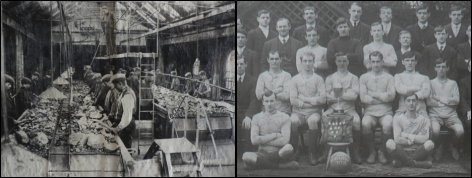by Esther Rind
In the UK, as in many other affluent countries, levels of physical activity have been declining in recent decades. In many areas with a history of heavy manual employment levels of physical activity are particularly low. This has been linked to a considerable reduction in work-related activities, coupled with a generally more sedentary life-style and the development of broader environmental factors unconducive to physical activity (e.g. increased traffic makes walking and cycling less safe and attractive). Furthermore, previous research has highlighted that participation in leisure-time physical activity is relatively low across those employed in physically demanding industries. Low levels of recreational physical activity in combination with a considerable loss of work activity would therefore result in particularly low activity levels in the former manual workforce.
In our latest publication we investigate how geographical variations in deindustrialisation between 1841 and 2001 are associated with current levels of overall physical activity and different activity types (e.g. recreational and job-related activities) in England. Here, the demand for manual employment has long been in decline and this has particularly affected jobs in the manufacturing, mining and agricultural sector (see figure 1).
 (Data: Statistical Atlas – A Vision of Britain Through Time, Great Britain Historical GIS-project)
(Data: Statistical Atlas – A Vision of Britain Through Time, Great Britain Historical GIS-project)
For 351 local authority districts (administrative units including metropolitan and non-metropolitan districts, unitary authorities and London boroughs), we developed a local measurement of industrial decline based on employment change in industries associated with heavy manual work in the manufacturing, mining and agricultural sector. This measure was linked to physical activity data for 27,414 individuals from the Health Survey for England. Our analysis showed that residents of districts characterised by a history of manufacturing and mining employment were particularly likely to report low activity levels. We conclude that deindustrialisation is a plausible factor in explaining present-day patterns of physical activity.
In a follow-up study we talked to residents living in the North-East of England who have directly experienced industrial decline in their neighbourhoods. This helped us to get a better understanding of why residents of communities particularly affected by deindustrialisation have particularly low levels of physical activity. We found that social, cultural and environmental changes have impacted activity behaviours through to today. For example, in former mining communities the loss of recreational facilities (e.g. bowling greens, football fields, swimming pools) is related directly to the closure of collieries which impacts recreational opportunities of residents till today.
 Working conditions and football club in a former mining community (Photos taken by author in the Beamish Museum.)
Working conditions and football club in a former mining community (Photos taken by author in the Beamish Museum.)
Our participants highlighted that local projects such as the re-development of public gardens and country parks with an industrial history (e.g. Beamish Museum) have recently gained an increase in visitors. The emotional link to the socio-cultural history of areas has been shown to be a strong motivator for communities to tackle adverse effects of industrial decline and evaluate future needs. We believe that this potential is a relatively unexplored but invaluable source to enhance physical activity in areas still affected by post-industrial decline.
